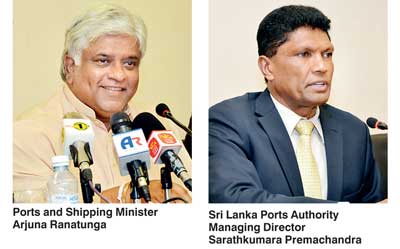Thursday Dec 12, 2024
Thursday Dec 12, 2024
Monday, 30 May 2016 00:00 - - {{hitsCtrl.values.hits}}
 By Himal Kotelawala
By Himal Kotelawala
A Cabinet decision has been taken to gradually covert the Galle Port into an exclusive leisure port, following a total shift of its naval base to the Hambantota Harbour in the near future, Minister of Ports and Shipping Arjuna Ranatunga revealed last week.
At a ‘Meet the Minister’ Q&A session held at the National Chamber of Commerce of Sri Lanka with the participation of Sri Lanka Ports Authority (SLPA) officials and industry leaders, Ranatunga said the Government is contemplating proposals received from, among others, a yacht club, in its efforts to make the Galle Port a central location in the country’s south, which he said the Government has identified as a tourist promotion area.
“There are two proposals we have already got. Ultimately Galle will end up as a leisure port. We have taken a Cabinet decision to shift the Navy from Galle to Hambantota. We have already done their terminal. It will be very costly, but slowly we have to – without hurting them; you know they have protected some of the ports for the last so many years. It’s not that we’re trying to push them out, but we need to take some decisions that will be very positive for the country,” he said.
Decisions in this regard are likely to be finalised within this month, he added.
The Chinese government has, meanwhile, proposed a project to develop a four square-kilometre (1000 acre) industrial zone adjacent to the Hambantota port in order to ‘activate the economy there’, SLPA Managing Director Sarath Premachandra said. This will be in addition to a ship-building and dry dock project for which feasibility studies are already underway.
“Land area has been allocated within the port of Hambantota for this large dry dock facility that can take very large ships. We have already two parties investing in LPG and LNG. The car carrier’s already handled, and roughly 150,000 vehicles of transshipment are already being handled at the Hambantota port,” he said.
According to Premachandra, two requests for proposals (RFPs) have already been made: One to select a bunker supply for bunkering and storage of bunker fuel at the Port of Hambantota, and the other looking for more investors to launch port related business industries.
“We have not specified what kind of entities. We have given potential investors the opportunity to decide what they could do with the port of Hambantota – i.e. what’s already developed as well as remain to be developed in the future,” he explained.
Minister Ranatunga said these can be confirmed within the next two to three weeks.
The Trincomalee harbour, according to Ranatunga, will come under the purview of the proposed and much publicised Megapolis development drive.
“The Prime Minister has requested a Singaporean company to do the feasibility report on that. As soon as we get that, we will look at Trincomalee with the Megapolis proposal,” he said.
The Government is also looking at utilising railway to transfer containers from both the Hambantota and Trincomalee ports, it was revealed during the Q&A session.
“There is no immediate demand to have a container terminal facility in Hambantota, but what could be feasible would be a rail link. Once Hambantota is linked by rail – this is the reality now – we’d be able to transport them by train to the port of Colombo, since the rail link is available up to the Jaya Container Terminal (JCT) now, and I know that the Transport Ministry is very much interested in reviving this link and restarting the transport of containers,” said Premachandra.
In Trincomalee, too, the Government is considering adopting the old railway tracks and, according to Ranatunga, Minister of Transport Nimal Siripala De Silva has already visited the area and has shown a keen interest in developing the railway tracks.
However, noted Ranatunga, it could be a costly enterprise, and the Government would have to take into account the small businesses who have invested in trucks and lorries.
“We can’t discount them straight away. We have so many transport associations and unions – I’m not worried about the union part – but there are some small scale businesses that survive with lorries, so we have to be very careful when taking a decision. But I’m positive that will be the future. Because we need to cut down the costs to survive in the industry,” he said.
Pix by Upul Abayasekara